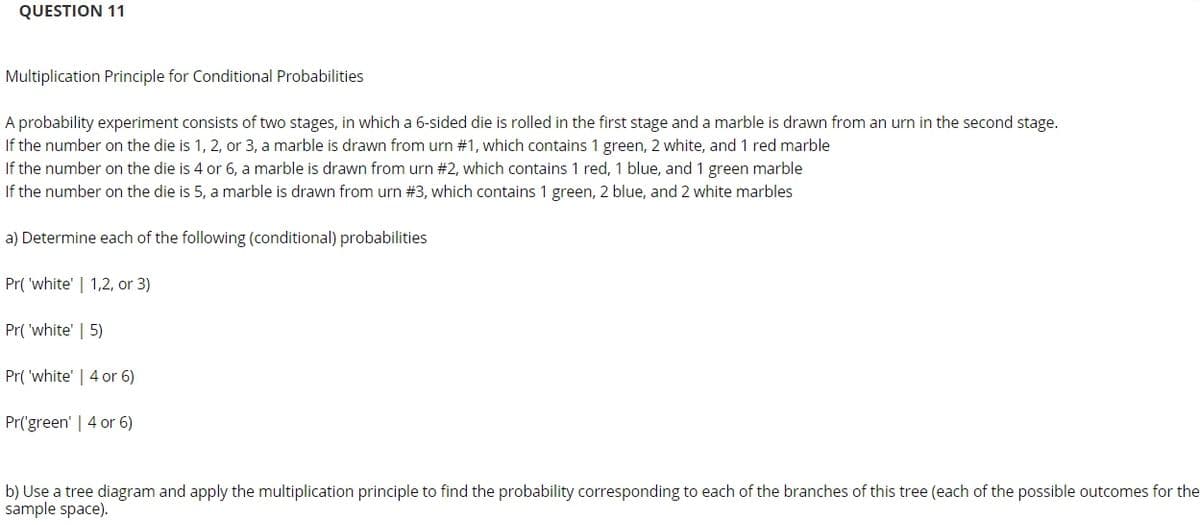A probability experiment consists of two stages, in which a 6-sided die is rolled in the first stage and a marble is drawn from an urn in the second stage. If the number on the die is 1, 2, or 3, a marble is drawn from urn #1, which contains 1 green, 2 white, and 1 red marble If the number on the die is 4 or 6, a marble is drawn from urn #2, which contains 1 red, 1 blue, and 1 green marble If the number on the die is 5, a marble is drawn from urn # 3, which contains 1 green, 2 blue, and 2 white marbles a) Determine each of the following (conditional) probabilities
A probability experiment consists of two stages, in which a 6-sided die is rolled in the first stage and a marble is drawn from an urn in the second stage. If the number on the die is 1, 2, or 3, a marble is drawn from urn #1, which contains 1 green, 2 white, and 1 red marble If the number on the die is 4 or 6, a marble is drawn from urn #2, which contains 1 red, 1 blue, and 1 green marble If the number on the die is 5, a marble is drawn from urn # 3, which contains 1 green, 2 blue, and 2 white marbles a) Determine each of the following (conditional) probabilities
Holt Mcdougal Larson Pre-algebra: Student Edition 2012
1st Edition
ISBN:9780547587776
Author:HOLT MCDOUGAL
Publisher:HOLT MCDOUGAL
Chapter11: Data Analysis And Probability
Section11.8: Probabilities Of Disjoint And Overlapping Events
Problem 2C
Related questions
Topic Video
Question
100%
Can someone please help me with these questions.

Transcribed Image Text:QUESTION 11
Multiplication Principle for Conditional Probabilities
A probability experiment consists of two stages, in which a 6-sided die is rolled in the first stage and a marble is drawn from an urn in the second stage.
If the number on the die is 1, 2, or 3, a marble is drawn from urn #1, which contains 1 green, 2 white, and 1 red marble
If the number on the die is 4 or 6, a marble is drawn from urn #2, which contains 1 red, 1 blue, and 1 green marble
If the number on the die is 5, a marble is drawn from urn #3, which contains 1 green, 2 blue, and 2 white marbles
a) Determine each of the following (conditional) probabilities
Pr( 'white' | 1,2, or 3)
Pr( 'white' | 5)
Pr( 'white' | 4 or 6)
Pr('green' | 4 or 6)
b) Use a tree diagram and apply the multiplication principle to find the probability corresponding to each of the branches of this tree (each of the possible outcomes for the
sample space).
Expert Solution
This question has been solved!
Explore an expertly crafted, step-by-step solution for a thorough understanding of key concepts.
This is a popular solution!
Trending now
This is a popular solution!
Step by step
Solved in 5 steps with 3 images

Knowledge Booster
Learn more about
Need a deep-dive on the concept behind this application? Look no further. Learn more about this topic, statistics and related others by exploring similar questions and additional content below.Recommended textbooks for you

Holt Mcdougal Larson Pre-algebra: Student Edition…
Algebra
ISBN:
9780547587776
Author:
HOLT MCDOUGAL
Publisher:
HOLT MCDOUGAL

Algebra & Trigonometry with Analytic Geometry
Algebra
ISBN:
9781133382119
Author:
Swokowski
Publisher:
Cengage


Holt Mcdougal Larson Pre-algebra: Student Edition…
Algebra
ISBN:
9780547587776
Author:
HOLT MCDOUGAL
Publisher:
HOLT MCDOUGAL

Algebra & Trigonometry with Analytic Geometry
Algebra
ISBN:
9781133382119
Author:
Swokowski
Publisher:
Cengage
